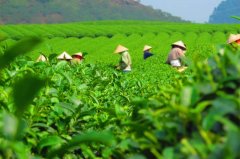Drought + epidemic situation Darjeeling black tea production in India continues to rise
Under the impact of the dry weather and the COVID-19 epidemic, the harvest season in India's important tea-producing areas is facing the double threat of declining production and stagnant tea production, which may cause tea prices, which have already risen for a wave, to continue to rise.

As the Indian government tries to prevent the epidemic from spreading to 800 tea-producing areas across the country, the Indian Tea Association said at least 90 tea gardens in Assam, an important tea-producing region, had reported confirmed cases and many declared closed areas, according to the FT.
About 500 confirmed cases have been confirmed in Indian tea gardens, but tea farmers say more tests are needed to know the true scale of the epidemic.
Tea farmers warn that failure to control the epidemic could hit the tea harvest season and push up prices. India is the world's second-largest tea producer after Chinese mainland.
Assam and West Bengal are important producing areas of Darjeeling black tea, both of which have reported a surge in the number of cases of COVID-19, and experts say local elections held in these two regions have contributed to the spread of the epidemic. Labor groups blame the sharp increase in diagnoses on the narrow working environment in the tea garden.
India's tea industry is suffering multiple negative blows, from unstable weather patterns caused by climate change to last year's blockade that led to a suspension of tea harvests for several weeks.
Falling production pushed Indian tea prices to record highs last year, giving Kenya and Sri Lanka a competitive advantage in the tea export market. Idoniboye, an analyst at Mintec, a commodity data company, said the recent blow to India's tea-producing areas would give tea-producing countries such as Sri Lanka an opportunity to sell more tea to big tea consumers such as Russia.
The severe drought is threatening tea growth in Assam and northeastern India, which is exacerbated by the epidemic. Tea trader Reese said that North India produced 47 million kilograms of tea in March, higher than last year, but still lower than the 60 million kilograms harvested in the last "normal year" in March 2019. According to Mintec, tea sold at auction in Calcutta, India, for 287.5 rupees a kilogram in April, up more than 40 per cent from a month ago.
- Prev

Yi Gang: the people's Bank of China plans to implement a system of compulsory disclosure of climate information.
The people's Bank of China will support the development of a standardized international climate reporting framework, further improve the classification of green bonds with the European Union and the United States, and plan to implement mandatory disclosure of climate-related information, urge major domestic commercial banks to disclose carbon information, and then urge domestic listing.
- Next

Latest report: Increased warming will reduce global tea production
Tea plantations will be hit hard by global warming and tea production could fall sharply in the coming decades, according to a new study released Tuesday by Christian Aid, a charity
Related
- A one-day flower show brings 130 million yuan in orders! Nanhai, this Phalaenopsis exhibition is amazing
- What do the flower language and meaning of Lutheran tree mean? Precautions for planting Lutheran tree
- Encounter Chaoshan Kongfu tea, not without this cup of Phoenix single clump
- The durian market in Vietnam and Thailand is flooded. The price of imported durian has plummeted by 30-40% in a month.
- Shanghai solved the problem of local vegetable supply by planting 80,000 mu of green leafy vegetables.
- Wageningen University has become the best agricultural university in the world for the seventh time in a row.
- The strongest export season of South African grapes is full of challenges, with exports to Russia falling sharply by 21%.
- Sri Lanka is on the verge of bankruptcy, "Tea for debt" Organic Agriculture Revolution aggravates the Food crisis?
- Turning waste into earthworm manure and worm manure into organic fertilizer-A new choice for auxiliary farming
- Organic rice growers shoulder the responsibility of nurturing agricultural talents! Yinchuan Sustainable Farm with Organic Life Camp

